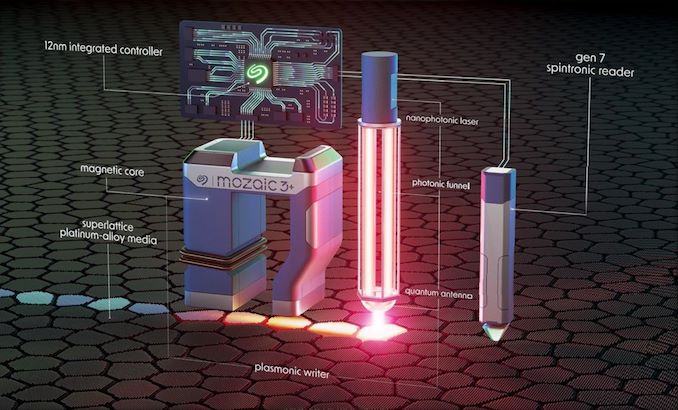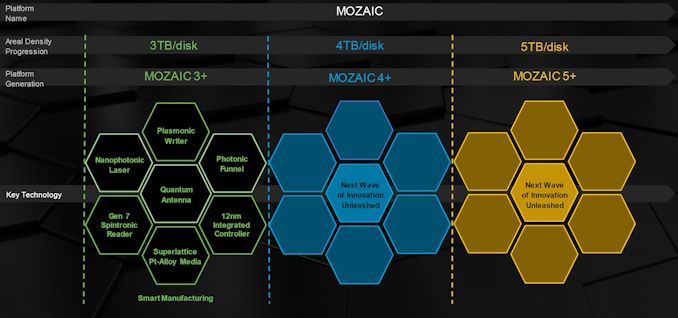Seagate Unveils Mozaic 3+ HDD Platform as HAMR Readies for Volume Ramp
by Ganesh T S on January 17, 2024 6:00 AM EST
Seagate's financial reports have been indicating imminent mass production of HAMR HDDs for a few years now, and it looks like the wait for these drives to appear in retail is finally at an end. The Seagate Exos product family is getting a 30TB capacity point, thanks to the use of heat-assisted magnetic recording (HAMR) technology. The company talked to the press last week about the Mozaic 3+ platform – their first high-volume HAMR platform – and how it sets the stage for rapid areal density scaling over the next few years.
Seagate's new Exos 30TB HDDs use platters with an areal density of 3TB per platter, and Seagate has plans to scale that up at a rate of up to 20% generation-over-generation in the next few years (compared to the 8% rate that CMR HDD capacities have been growing at in the last decade or so). The company indicated that volume shipments are happening this quarter to hyperscalers. Seagate is observing that the average customer upgrading from a 16TB conventional magnetic recording platform to the new 30TB+ HDDs can almost double the capacity of their server racks in the same footprint, as the new drives are drop-in replacements. This brings TCO benefits, particularly in terms of power consumption. The company is even quantifying that - the Exos X16's average power consumption of 9.44W translates to 0.59W / TB. The new Exos 30TB's equivalent number is a bit higher at 10.5W, but that translates to a 40% power savings on a per-TB basis at 0.35W / TB.
The company stressed upon the fact that HAMR needed a host of other breakthroughs grouped under the new Mozaic 3+ tag in order to achieve the areal density breakthrough enabling the new Exos family. These include:
- Platters using new Pt-Fe alloy
- Plasmonic writer
- 7th Gen. spintronic reader
- 12nm integrated controller
Areal density gains are primarily driven by smaller grain sizes in the magnetic media. However, legacy magnetic platter media is not stable at very small grain sizes. Along with Showa-Denko, Seagate has developed a superlattice iron-platinum structure with increased magnetic coercivity to allow for precise and stable data recording. The HAMR process requires heating up of the grain in order to alter its state, and Seagate has achieved this using a nanophotonic laser that is vertically integrated into the plasmonic writer sub-system. The reading head has also needed to evolve in order to tap into the smaller grains. All of these advancements work together thanks to a newly developed controller (built on TSMC's 12nm process) that Seagate claims to deliver 3x the performance of existing solutions.
Seagate expects the Mozaic platform to lead to 5TB/platter as early as 2028.
Areal density scaling is one of the key aspects in addressing the HDD capacity issue. One aspect that this scaling has not addressed is the IOPS/TB metric, where SSDs are in a much better place to take advantage of advancements in host interface technology. The Mozaic platform is orthogonal to currently-used HDD technologies such as dual actuators and shingled-magnetic recording. Additional benefits can be gleaned from those, but the IOPS/TB metric scaling is an aspect that needs industry-wide efforts to address to keep HDDs relevant in more application areas.
Seagate works with vendors such as Showa-Denko for the platters and TDK for the recording heads. Some of the Mozaic 3+ innovations have been jointly developed with them. While the exact details of the joint development are confidential, Seagate indicated that they have a time-limited exclusive use for these technological advancements. If, and when, other HDD vendors move to HAMR, it appears that Seagate has a healthy lead to fall back on with respect to these core HAMR platform components. The company is also expecting the Mozaic 3+ technology to address use-cases as as NAS, and video / imaging markets. It is only a matter of time before HAMR moves from Exos to the IronWolf and SkyHawk families.













29 Comments
View All Comments
abufrejoval - Wednesday, January 17, 2024 - link
It was only after I had replaced the previous NVMe drives on one of my main systems (1 and 2TB with 2x4TB) a few days ago, that I realized that overall its solid state capacity had surpassed the capacity of any current HDD, because that system also sports 8 SATA SSDs at 2TB each (4 onboard SATA + 4 via an extra M.2 SATA adapter).It's split between Windows and a ZFS pool on Linux, so I don't tend to think of it as "one storage", but still I couldn't back it up to an HDD any longer if I wanted to...
It's been a long journey, I remember experimenting with CF to PCMCIA and IDE adapters to run PCs on flash storage, with varying degrees of success.
And my very first Intel Postville 160GB SATA SSD still runs on my firewall today, showing no signs of being worn out.
I still yearn for the easy hot-swap expandability and replacability of SATA, but even with SATA RAID0, NVMe is hard to beat in physical size and speed.
HDD to me has been a tape replacement for a long time, but those tapes need to keep up!
Fallen Kell - Wednesday, January 17, 2024 - link
You just need U.2 or U.3 nvme storage solutions to finally hit the home market, with motherboards directly supporting U.2 or U.3 ports instead of M.2. This won't ever happen until Intel and AMD finally give up on limiting PCIe lanes in their "consumer" CPU's and start putting 96-128 lanes in the systems.Samus - Wednesday, January 17, 2024 - link
The irony is LTO tapes have been faster than any single hard disk for a decade. Newer generation LTO tapes are even faster as depending on the compression, many can write over 1GB\second, saturating many RAID arrays, causing the buffer overruns, resulting in compression adjustments or worse, spindle parking while the array catches back up. That's just ridiculous to comprehend. Every corner of the storage community has kept up with performance AND capacity in a linear fashion except hard disk storage.HaninAT - Wednesday, January 17, 2024 - link
LTO-9 FTW! The tapes aren't too costly either.markhahn - Sunday, February 4, 2024 - link
no, just 400. quoting compressed speed is just a marketing cheat.not sure why it's a complaint against tape that its linear bandwidth is modestly higher than disk. there are some compromises when you design heads to move around, rather than sit placidly while media flows by ;)
Dante Verizon - Wednesday, January 17, 2024 - link
What is the writing and reading speed ? 500MB/s?RedGreenBlue - Sunday, March 31, 2024 - link
Just want to remind anyone who sees this article that Seagate’s blog post from 2018 is still up and read: “Built over 40,000 HAMR drives; pilot volume in 2018, volume shipments of 20TB+ drives in 2019; drives are built on the same automated assembly line as current products”Seagate and Western Digital have been saying HAMR or MAMR are just around the corner for over 10 years. At some point it becomes questionable beyond marketing hype as to whether it’s stock price manipulation and if the Securities and Exchange Commission should investigate them.
RedGreenBlue - Sunday, March 31, 2024 - link
May have been 2017 https://blog.seagate.com/craftsman-ship/hamr-next-...RedGreenBlue - Sunday, March 31, 2024 - link
But some publications claim the market is eating it up as another AI play, even though it isn’t much of one. https://www.wsj.com/livecoverage/stock-market-toda...